Evidence
PROSPER is scientifically proven to work.
PROSPER has been evaluated and shown to be an effective way to deliver and sustain evidence-based programs.
In 2001, a randomized-controlled evaluation of PROSPER began which included approximately 11,000 youth and their parents from 28 communities in Iowa and Pennsylvania. Researchers from Iowa State and Pennsylvania State Universities continue to collect data from this original group of youth who are now young adults. This long-term research project has made it possible to learn about how having PROSPER in their schools and communities during middle school has positively influenced them throughout each of the phases of their lives, all the way into young adulthood – when many of them now have children of their own. There have been over 100 publications showing the effectiveness of the PROSPER delivery system. Below are some of the key highlights and take-home messages from this huge body of research.

PROSPER communities have 20% less opioid use among 12th graders.

Source: Spoth, Trudeau, Shin, Ralston, Redmond, Greenberg & Feinberg (2013). Longitudinal effects of universal preventive intervention on prescription drug misuse: Three RCTs with late adolescents and young adults. American Journal of Public Health, 103, 665-672.
Youth in PROSPER communities report spending more time doing activities with their parents, more warmth in their relationship with their parents, and a more positive family environment than youth who are not in PROSPER communities.

Redmond, C., Spoth, R. L., Shin, C., Schainker, L. M., Greenberg, M. T., & Feinberg, M. (2009). Long-term protective factor outcomes of evidence-based interventions implemented by community teams through a community–university partnership. The Journal of Primary Prevention, 30(5), 513-530.
For every $1,000 spent by non-PROSPER communities on the SFP 10-14 family-based program, PROSPER communities spend as little as $328.

Crowley, D. M., Jones, D. E., Greenberg, M. T., Feinberg, M. E., & Spoth, R. L. (2012). Resource consumption of a diffusion model for prevention programs: The PROSPER delivery system. Journal of Adolescent Health, 50(3), 256-263.

